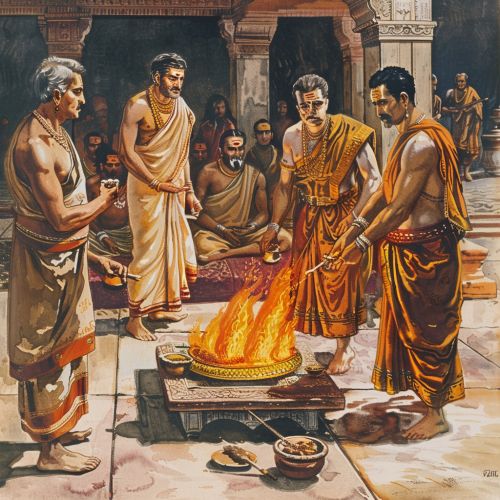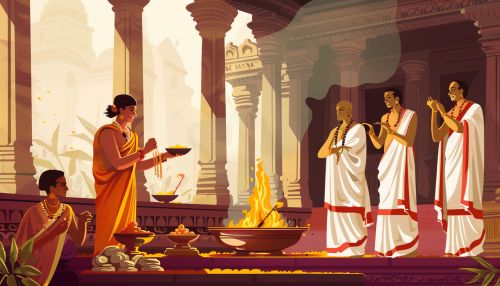Vedic Civilization: Difference between revisions
(Created page with "== Introduction == The Vedic Civilization, also known as the Vedic Period, is a significant era in the history of the Indian subcontinent. It is named after the Vedas, the oldest scriptures of Hinduism, which were composed during this period. The civilization is believed to have flourished between 1500 BCE and 500 BCE, following the decline of the Indus Valley Civilization. The Vedic texts provide a wealth of information about the social, political, and religiou...") |
No edit summary |
||
| Line 11: | Line 11: | ||
The Early Vedic Period was marked by the migration of the [[Indo-Aryans]] into the Indian subcontinent. These people were primarily pastoralists, and their society was organized into tribes led by chieftains known as [[Rajas]]. The Rigveda, composed during this period, consists of hymns dedicated to various deities such as [[Indra]], [[Agni]], and [[Soma]]. | The Early Vedic Period was marked by the migration of the [[Indo-Aryans]] into the Indian subcontinent. These people were primarily pastoralists, and their society was organized into tribes led by chieftains known as [[Rajas]]. The Rigveda, composed during this period, consists of hymns dedicated to various deities such as [[Indra]], [[Agni]], and [[Soma]]. | ||
[[Image:Detail-91677.jpg|thumb|center|Illustration of a Vedic ritual being performed by priests.|class=only_on_mobile]] | |||
[[Image:Detail-91678.jpg|thumb|center|Illustration of a Vedic ritual being performed by priests.|class=only_on_desktop]] | |||
=== Later Vedic Period === | === Later Vedic Period === | ||
Latest revision as of 04:01, 20 June 2024
Introduction
The Vedic Civilization, also known as the Vedic Period, is a significant era in the history of the Indian subcontinent. It is named after the Vedas, the oldest scriptures of Hinduism, which were composed during this period. The civilization is believed to have flourished between 1500 BCE and 500 BCE, following the decline of the Indus Valley Civilization. The Vedic texts provide a wealth of information about the social, political, and religious life of the people during this time.
Historical Context
The Vedic Civilization is divided into two main periods: the Early Vedic Period (1500–1000 BCE) and the Later Vedic Period (1000–500 BCE). The Early Vedic Period is characterized by the composition of the Rigveda, the oldest of the Vedas. The Later Vedic Period saw the composition of the other three Vedas: the Samaveda, Yajurveda, and Atharvaveda.
Early Vedic Period
The Early Vedic Period was marked by the migration of the Indo-Aryans into the Indian subcontinent. These people were primarily pastoralists, and their society was organized into tribes led by chieftains known as Rajas. The Rigveda, composed during this period, consists of hymns dedicated to various deities such as Indra, Agni, and Soma.


Later Vedic Period
The Later Vedic Period saw significant changes in the social and political structure of the Vedic society. The tribes began to settle down and practice agriculture, leading to the formation of larger political units called Janapadas. The concept of Varna, or social classes, became more pronounced during this period, dividing society into four main classes: Brahmins (priests), Kshatriyas (warriors), Vaishyas (traders), and Shudras (laborers).
Social Structure
The Vedic society was patriarchal and hierarchical. The family was the basic unit of society, and the head of the family was known as the Grihapati. Women had a relatively high status in the early Vedic period, participating in religious rituals and having the right to education. However, their status declined in the later Vedic period.
Varna System
The Varna system was a cornerstone of Vedic society. It was a hierarchical system that divided people into four main classes based on their occupation and duties. The Brahmins were responsible for performing religious rituals and preserving sacred knowledge. The Kshatriyas were the warriors and rulers, responsible for protecting the society. The Vaishyas were the traders and agriculturists, while the Shudras were the laborers and service providers.
Religion and Philosophy
The Vedic religion was polytheistic, with a pantheon of gods and goddesses. The primary deities included Indra, the god of thunder and war; Agni, the fire god; and Soma, the god associated with a sacred ritual drink. The Vedic rituals were elaborate and involved the chanting of hymns, offerings to the deities, and the performance of fire sacrifices known as Yajnas.
Vedic Texts
The Vedic texts are divided into four main categories: the Samhitas, the Brahmanas, the Aranyakas, and the Upanishads. The Samhitas are collections of hymns, prayers, and mantras. The Brahmanas are prose texts that explain the rituals and ceremonies. The Aranyakas are texts that serve as a bridge between the ritualistic Brahmanas and the philosophical Upanishads. The Upanishads are philosophical texts that explore the nature of reality, the self, and the universe.
Economy
The economy of the Vedic civilization was primarily agrarian, with agriculture being the main occupation. The domestication of animals, particularly cattle, played a crucial role in the economy. The cow was considered sacred and was a symbol of wealth and prosperity. Trade and commerce also flourished, with the barter system being the primary mode of exchange.
Political Structure
The political structure of the Vedic civilization evolved over time. In the early Vedic period, the society was organized into tribes led by chieftains. These chieftains were chosen based on their valor and leadership qualities. The later Vedic period saw the emergence of larger political units called Janapadas, which were ruled by kings. The king was assisted by a council of ministers and priests in the administration of the kingdom.
Art and Culture
The Vedic civilization made significant contributions to art and culture. The Vedic hymns are considered masterpieces of ancient literature, and the rituals and ceremonies reflect a high degree of sophistication. Music and dance were integral parts of Vedic rituals, and the Samaveda is a testament to the importance of music in Vedic culture.
Legacy
The Vedic civilization laid the foundation for the development of classical Hinduism. The concepts and practices that emerged during this period, such as the Varna system, the performance of Yajnas, and the philosophical ideas in the Upanishads, have had a lasting impact on Indian society and culture.
